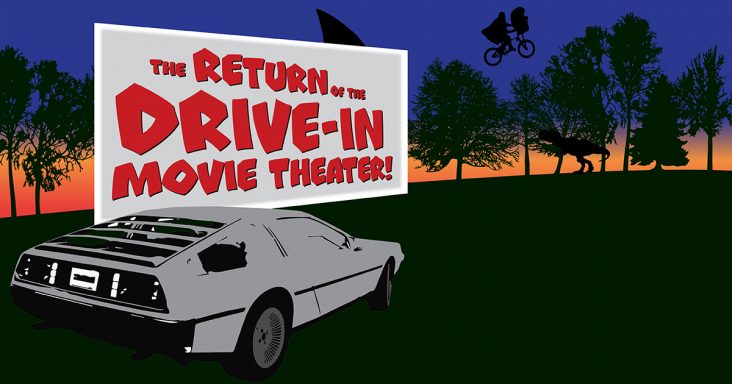Pandemic delivers the return of the drive-in movie theater
by August 9, 2020 10:14 am 2,466 views

Pocahontas High School and Hendrix College graduate Graydon Carter was living in New York City working toward his master’s degree in international affairs when the COVID-19 pandemic began to ravage the city. He came home and decided he might need to start a business venture.
He noticed that a lot of people from his hometown and surrounding areas where traveling to Mountain View to the Stone Drive-In Theatre, one of only three in the state. He partnered with his best friend from college, Joe Berry, and the two set out to start an outdoor theater in Randolph County, he told Talk Business & Politics. William Burgess, Carter’s future father-in-law and the owner of Power Technology Inc., provided the projector technology. Carter and Berry partnered with the James Ranch, which provided a large lot.
Within a couple of months their fledgling company CineArk was born, and they opened the James Junction drive-in movie theater near the James Ranch, a few miles south of Pocahontas. On July 10, “Jaws” showed on its big screen, and it was a first in more ways than one for Carter.
“I’d actually never been to a drive-in before our first show,” he said. “I’d always wanted to go. When I lived in New York, I went to the movies a lot. … Obviously with the pandemic going on, we need to socially distance. You can socially distance at a drive-in. We’re happy to give people something to do.”
In the weeks that followed the opening, Carter and his team showed other classic movies such as “Back to the Future,” “E.T. the Extra-Terrestrial” and “Jurassic Park.” Before the end of the summer they hope to have the technology to show first-run theatrical releases, he added.
Customers can park in the front rows for $20, while the back rows cost $15. Tickets can be bought online, and showtimes begin at dusk.
Carter, Berry and others spent months building the frame for the screen and projector booth, plus a concession stand. There was no prototype method for constructing a drive-in, so it required a lot of hands-on problem-solving, he said.
Drive-in theaters have been an American staple for almost 100 years. Richard Hollinghead was an avid movie fan who worked as the sales manager at his father’s company, Whiz Auto Products in Camden, New Jersey. His mother had problems with sitting in theater seats, so he formulated the idea of an open-air theater. He patented his idea in May 1933, and on June 6 of that year the first drive-in opened, according to History.com.
Hollinghead mounted the projector to his car at first, and the screen was stretched between some trees. He soon invested $30,000 and refined his concept, and the number of open-air theaters began to grow. Following World War II and the overturning of his patent, the number of these kinds of theaters exploded. During its peak from the mid-1950s through the end of the 1960s, more than 5,000 open-air theaters operated in the U.S.
Historians say the reason the theaters did so well during this time period was simple. Veterans returning from the war started having large families, and the so-called “Baby Boom” was underway. Larger families needed cheaper venues for entertainment, and drive-in theaters provided it.
Several factors led to the decline of open-air theaters. During the 1970s and ’80s, the number of sit-in theaters grew significantly. And with the advent of video stores in the 1990s, the open-air theaters’ market share was greatly reduced. Today, there are less than 500 of these types of theaters throughout the U.S.
The theater business in general is one of the largest entertainment sectors in the world. Global box office revenue topped $42 billion in 2019, according to the World Economic Forum. It was the largest tally ever, and it was part of $136 billion generated worldwide by movie production and distribution. The industry has been in free fall since the beginning of the pandemic, and the total damage done to the industry is still being calculated.
The goal at James Junction is to draw 40 to 50 cars per show. To this point, they’ve been averaging 80 or more cars.
“It’s been pretty hectic, but it’s been fun,” Carter said.
Their business model isn’t solely dependent on customers at James Junction. CineArk has a mobile projection unit, meaning they can go to different cities throughout the state to provide this type of entertainment, Carter said.
The idea is to offer outdoor video projection for churches, municipalities and other organizations. The company already has a contract to provide outdoor theater entertainment for the city of Benton during the last Saturday of each month until the end of the year. The goal is to generate more of these pop-up events, he added.
Most of the movies they hope to show will be family-oriented, he said. The plan is to conduct polls on the theater’s Facebook page to determine what movies people want to see and what days are best, he said. They even ask people what types of foods they’d like to see in the concession stand.
As the COVID-19 continues and it remains important to physically stay apart, Carter thinks his company will have a broad customer base. It’s early but they’ve been attracting customers from throughout Northeast Arkansas to what used to be a hay field in Randolph County. The projections are that the virus will remain through next year, and people will have to find alternative entertainment venues like James Junction.
“We really think there is a good market for this,” he added.
